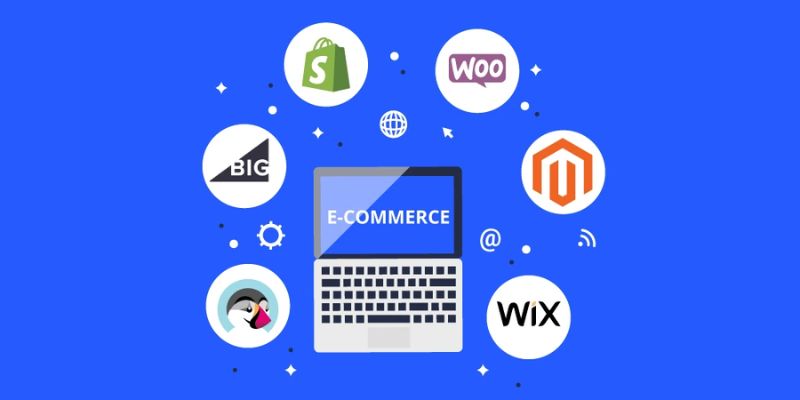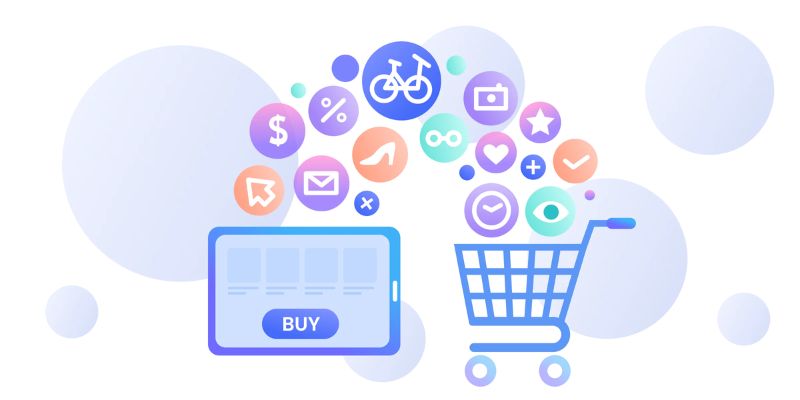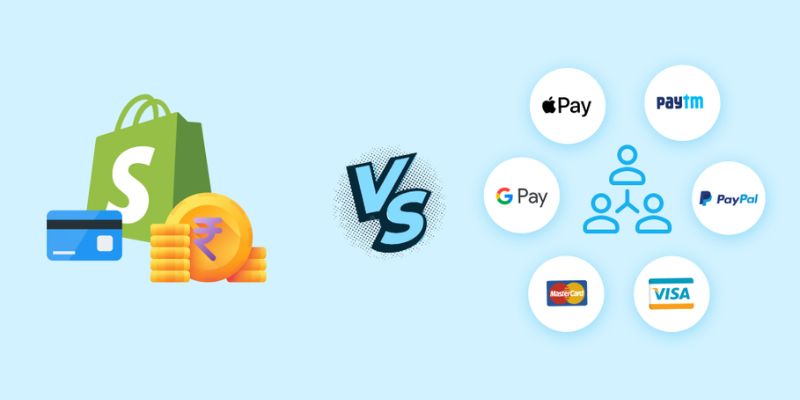Leading e-commerce platforms are like gladiators battling in the digital arena. Who stands tall in 2023? I’ve got the scoop. Let’s dive into who’s winning and why. You’ll learn how these giants are shaping the way we sell and buy online. Get ready for a feature showdown, big benefits for big retailers, and smart strategies that make or break success in the online marketplace. We’ll unpack the most user-friendly platforms, reveal how to scale your shop to mighty heights, and predict the future of online retail. Stick with me; your journey to mastering the e-commerce world starts here.
Market Leaders in E-Commerce: An In-Depth Analysis
Shopify vs BigCommerce: A Feature-Based Showdown
Let’s dig into two giants: Shopify and BigCommerce. You ask what sets them apart? For starters, Shopify is known for its ease of use. It’s a hit with many small shops for good reason. Its dashboard is clean, making setup quick. Adding products? Smooth sailing. It’s a top pick for those just starting out. BigCommerce joins the race with some hefty features. It aims at merchants eyeing growth without fuss. They pack more built-in sales tools than Shopify. Both cater to a variety of payment gateways, vital for selling across borders.
Currency issues? No problem. Both ace that. Yet remember, Shopify charges a fee unless you use Shopify Payments. BigCommerce doesn’t do that. So, if you don’t fancy extra fees, BigCommerce might be your winner. Marketing tools? Shopify’s SEO features are solid. They keep your store visible online. BigCommerce also stands strong here but can seem complex. And mobile shopping? Both get thumbs up. Sites built on either platform look great on phones and tablets. Sales won’t dip because someone shops on their mobile.
The Magento Edge: Unpacking Benefits for Large-Scale Retailers
Now we eye Magento, the powerhouse. When we touch on Magento benefits, think grand scale. Do you run a large store with custom needs? Magento shines bright. It’s open-source, so it flexes and bends to your wants. Magento asks for strong tech chops though. It’s not for the faint-hearted or tech newbies. Large merchants love it. Why? It’s a wizard in handling vast catalogs and complex shipping needs.
Security? They’ve got that sorted. With Magento, you get robust security tools. They’re designed to protect your grand business dealings. Custom builds are Magento’s playground. If unique shopping experiences are your game, gear up. Magento is your MVP for building something truly bespoke. Speaking of growth, Magento’s scalability is unmatched. Gear up for growth spurts without hiccups.
Both these e-commerce leaders liven up digital sales channels. The big question: which one to choose? Ponder your scale, tech skill, and where you see your shop in a few years. Then, pull the trigger. Whether you’re a lone wolf starting fresh or a big dog with custom needs, there’s a leader waiting for you.

E-Commerce Platform Usability & Merchant Success
Optimizing User Experience: A Look at WooCommerce
WooCommerce makes online shopping easy. Think of a shop where you enjoy buying. WooCommerce aims to be its digital twin. This free tool turns a WordPress site into an online store fast. Its advantage lies in flexibility. You can sell goods, downloads, or even appointments.
Its design fits both small shops and large sellers. The tool grows with your business. As you grow, you add more features. Some cost money, though. For user experience, it’s a hit. People find what they need and check out quick. Sites using WooCommerce vary, each unique to the seller. This keeps shoppers engaged and coming back.
For small businesses, this platform is often the top choice. Cost efficiency is key here. This is why you see so many using it. Good SEO tools help your store show up in searches. There’s also strong support for mobile users. These factors boost sales.
Now, the right payment gateway is vital. WooCommerce supports many, like PayPal and Stripe. When people pay easily, they love the shopping experience more.
Strategic Expansion: How Amazon Marketplace Shapes Online Selling
Amazon Marketplace lets sellers reach the world. But how? It’s simple. It gives access to Amazon’s huge customer base. Think about it. You start selling and right away, millions can see your goods. This is their strategy. They mix your offers with their products.
The marketplace is big on customer trust. They keep things safe and solve issues. When buyers trust, they shop more. The site is easy to use, too. You list products, manage inventory, and even get help shipping.
Here’s more good news. They teach you about pricing and staying competitive. Their tools help you understand the market. You learn what buyers want. This is why Amazon keeps its place as a top e-commerce solution.
Small businesses gain a lot here. They become part of a big shopping destination. They get tools to track sales and learn about their customers. This helps them sell more. It’s not just about putting products online. It’s about reaching people who are ready to buy.
In summary, WooCommerce and Amazon Marketplace show us two paths to online selling. Both focus on giving us, the users, the best time shopping. For success in e-commerce, think like a shopper. Offer what they love, and they will come.

Scalability and Security: Building Robust Online Stores
Assessing SaaS and On-Premise Solutions for Growth
Businesses ask, “Should we use SaaS or on-premise e-commerce?” The short answer: It depends on the business size, tech know-how, and growth plans. SaaS, or Software as a Service, gives you a full package: hosting, support, and updates. Think Shopify or BigCommerce. They shine with ease of use and quick set-up. They are top e-commerce solutions for quick scale. Small business or startup? Bet on SaaS for a head start.
But, there’s on-premise software too. That’s where you run everything: server, updates, security. This choice suits big firms fine. It means more control and customization. For example, Magento lets large retailers shape their store deep down. Big business loves Magento for this.
Here’s the deal: SaaS is best for small to mid-sized firms. Bigger brands with tech muscle may lean on-premise for top flexibility. Still, the best e-commerce websites keep growing. They might start with a SaaS platform. As they grow bigger, they may switch to on-premise for more control.
Implementing Security Best Practices in E-Commerce
Now, let’s talk shop on security. It’s a key piece of online shopping platforms. Top security practices keep customer trust up and bad actors out. Whether it’s Shopify features protecting against fraud or Amazon Marketplace strategy for secure payments, e-commerce security best practices are vital.
Rule one: Keep software up to date. Rule two: Use strong passwords, and change them often. Rule three: Keep checkout secure with SSL—that padlock icon next to the URL. This keeps shoppers’ data safe as houses. Big names like WooCommerce mix these rules with their own tricks for an iron fort.
Next, payment gateway support must be strong like a bull. Top e-commerce solutions have it in spades. They handle credit cards and protect against sneaky fraud. User reviews on e-commerce products say a lot about trust. Users highlight how secure they feel on these platforms.
Stores need to grow without a hitch. Scalability of e-commerce systems matters. It helps when big sales times hit. At the same time, never get careless with security. Hackers always look for a weak spot. Good e-commerce platform integrations work double shifts. They help your store grow and stay locked down tight.
Bottom line: For growth, match your business needs. Pick SaaS or on-premise accordingly. Always, always strap in tight with top-notch security. This keeps your store and customers safer than ever. Scalable, secure e-commerce platforms are the backbone of digital stores today. Choose wisely and grow your online store to the moon!

Integrations and Advancements: The Future of Online Retail
Multi-Channel Software and Inventory Synergy
Big online brands must handle lots of products. They sell on their sites, apps, and other places like Amazon or eBay. To stay on top, they need to connect all their sales channels. This means when a toy sells on their site, it also shows as sold on Amazon. It’s like a team where everyone knows what’s going on. This is called “multi-channel e-commerce software.” It links everything.
This linking helps them keep track of their stock. Say they have 100 video games. When ten are sold, the system knows there are only 90 left. This “inventory management in e-commerce” is key to happy customers. No one wants to buy a game that’s actually out of stock.
Personalized Shopping Experiences: Leveraging Mobile Commerce & AI
Let’s talk about how tech like AI makes shopping cooler for you. Everyone likes feeling special, right? Imagine going into a store, and the clerk knows just what you like. “Hey, want more of those cookies you love?” That’s what AI does, but online. It looks at what you like and shows you things it thinks you’ll want. This is a “personalized shopping experience.”
And with so many of us shopping on our phones, online stores have to be easy to use there. The term for this is “mobile commerce growth.” It’s about making sure you can shop just as well on your phone as at your computer.
AI makes mobile shopping even better. It can chat with you, help you find items, and more. Using AI, stores can keep you happy and coming back.
In the world of e-commerce, things always change. Every year, the best brands find new ways to make shopping online even better. They use software that talks to each other and knows what you like. This is 2023, and shopping has never been this smart or easy.
In this blog we dove deep into the giants of e-commerce. From Shopify and BigCommerce’s epic face-off to Magento’s edge with hefty stores, these platforms shape how we sell and grow online. We saw how WooCommerce can make online shopping a breeze for users. Meanwhile, Amazon Marketplace stays a beast in strategic selling.
We also tackled tough stuff like making sure our online stores can grow big and stay safe. SaaS and on-premise options were on the table, and we learned how crucial top security is for our shops.
Lastly, we peeked into retail’s future, where multi-channel tools and smart tech like AI make buying personal and easy no matter where you are.
So, let’s keep learning, selling, and growing. The web’s the limit!
Q&A :
What are the top e-commerce platforms used by online businesses today?
When looking at the digital marketplace, a few e-commerce platforms stand out due to their popularity and feature set. Historically, platforms like Shopify, Magento, WooCommerce, and BigCommerce have been at the forefront for many businesses. These platforms are renowned for their user-friendly interfaces, extensive customization options, and robust support communities.
How do leading e-commerce platforms enhance the online shopping experience?
Leading e-commerce platforms enhance the shopping experience by providing seamless navigation, mobile optimization, and personalized content. They integrate advanced technologies such as AI-powered search and recommendations, secure payment gateways, and efficient customer service tools to ensure that customers enjoy a convenient and safe shopping journey.
Do leading e-commerce platforms support mobile commerce and responsive design?
Absolutely, mobile commerce and responsive design are top priorities for leading e-commerce platforms. Platforms like Shopify, WooCommerce, and others offer mobile-friendly themes and responsive design templates that ensure online stores function flawlessly across all devices, thereby catering to the growing number of customers shopping on their smartphones and tablets.
What are the SEO benefits of using a leading e-commerce platform?
The major e-commerce platforms come packed with SEO-friendly features that help online stores to rank higher in search results. These benefits include customizable meta tags, auto-generated sitemap.xml files, effective URL structures, and the ability to integrate with various SEO tools and apps. This enables e-commerce sites to improve their visibility and attract more organic traffic.
How do leading e-commerce platforms address security concerns?
Security is a primary concern for both merchants and customers. Leading e-commerce platforms confront this by offering a range of security features such as SSL certification for secure transactions, protection against fraud with PCI DSS compliance, regular security patches, and robust data encryption. By doing so, they help ensure that both user data and business operations are safeguarded against potential cyber threats.

